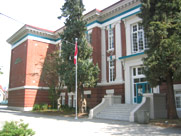THE COMMUNITY SCHOOLS OF BURNABY SCHOOL DISTRICT
Burnaby’s Community School model was established in 1976 as a result of a strong partnership between the school district and the City of Burnaby. The first school to become a community school was Lochdale Elementary. At the time, it was one of the first community schools in the province. Today there are seven elementary community schools within the Burnaby School District: Edmonds, Gilmore, Lochdale, Maywood, Second Street, Stoney Creek,and Stride Avenue. There is also a secondary community school at Byrne Creek.
 Community schools are regular schools with special belief in, and emphasis on, the value of community involvement. Each community school also has a coordinator who works on many of the special offerings and programs within the community school. A community school can become the neighbourhood hub, a centre where students, staff, families, residents, agencies and local businesses work together to build a strong and caring community. It is an accessible place where people find support, ideas and new friends. Community schools offer a variety of programs and services to meet the specific educational, recreational and social needs of the area it serves.
Community schools are regular schools with special belief in, and emphasis on, the value of community involvement. Each community school also has a coordinator who works on many of the special offerings and programs within the community school. A community school can become the neighbourhood hub, a centre where students, staff, families, residents, agencies and local businesses work together to build a strong and caring community. It is an accessible place where people find support, ideas and new friends. Community schools offer a variety of programs and services to meet the specific educational, recreational and social needs of the area it serves.
Burnaby Community Schools – The 6 Goals 
Burnaby Community Schools Placemat 
OBJECTIVES
Community schools place special emphasis on the following objectives:
- the utilization of all resources in the community to enhance the development of basic learning skills;
- the encouragement of community participation and involvement;
- the effective use of school facilities for people of all ages;
- the development of working relationships with public and private agencies; and
- the development of the school as a resource for the whole neighbourhood.
A community school:
- increases the use of local public school facilities;
- integrates and coordinates existing public services;
- maximizes communication between school and community;
- enriches and enhances learning through formal and informal activities;
- develops the neighbourhood school as a centre of community activities and services;
- reinforces a sense of community and improves the quality of life in the neighbourhood; and
- provides an opportunity for local residents to actively participate in their communities.
INVOLVEMENT
Community schools strive to involve local residents in a variety of ways. Each designated community school has a community council with broad local representation. This council promotes the free exchange of ideas, identifies local needs, and participates in decision-making and feedback for areas of local concern.
Parents and local residents are involved in their community school on an on-going basis as volunteers, instructors, participants, and members of the community council. A common way for local residents to become involved is through participation on the community council, which identifies needs and initiates programs and services available through the school. In addition, there is a broad scope for volunteer activity in a community school, with staff and residents working in an environment of cooperation to make the school a productive and comfortable place.
COMMUNITY SCHOOL COORDINATOR
The Community School Coordinator develops, coordinates and supervises community programs and services for all age groups in a given community school area. The programs include educational, recreational, cultural, health and social concerns. Programs developed and operated are intended to be consistent with the needs and interests expressed by the community and the various social agencies working in the community and with the policies of the board. The coordinator works closely with the Community Advisory Council for their assigned community school, and is also responsible for:
- coordinating, utilizing and developing a wide variety of services and programs in areas of education, social services, health, recreation and community services for the school and community;
- the organization, operation and general management of all community education sponsored programs activities and to ensure the adequate supervision of these activities;
- assisting City of Burnaby departments such as Social Planning and Parks, Recreation & Cultural Services, in planning and delivering needed social, cultural and educational services to all age groups in the community;
- assisting school staff in improving school/community relations, identifying community resources and developing programs and support services which complement and enhance the school’s curricular program and student learning; and
- working closely with the Ministry of Children and Family Development, Fraser Health Authority, other community organizations and neighbourhood residents to address community and school concerns.
PROGRAMS AND SERVICES
Each community school has unique programming designed to meet the specific educational, recreational and social needs of the area it serves.
This may include:
- regular Kindergarten to Grade 7 curriculum;
- increased opportunities for students to extend and enrich basic skills;
- training and leadership opportunities for volunteers;
- daytime, evening and weekend programs for all ages;
- education upgrading and other adult continuing education courses;
- coordination of agency services for children and families;
- neighbourhood information centres;
- early learning opportunities including preschool and child care, youth and immigrant services;
- support for neighbourhood improvement projects and;
- extended use of school facilities.